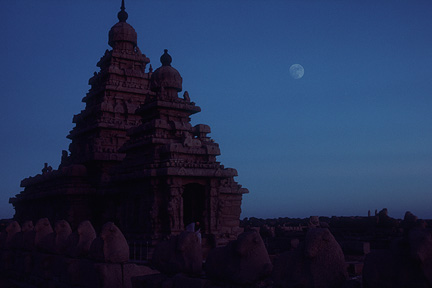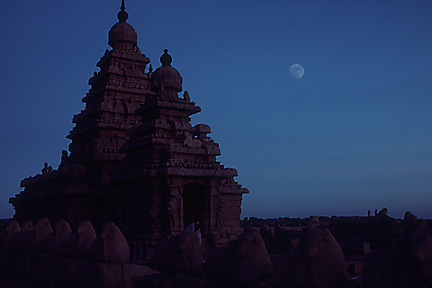To get the best quality out of any digital image, whether scanned from film or captured with a digital camera, you must compensate for the mathematically unavoidable loss of perceived sharpness that results from digitization. Likewise, whenever reproducing an image in a medium that relies on dots (whether the halftone dots of offset printing or the pixels of a computer monitor), there is additional, process-specific softening to anticipate and neutralize. Fortunately, there are good algorithms that perform the needed sharpening. For historical reasons, the sharpening process is often called "unsharp masking."
capture sharpening
Capture sharpening should compensate for softness introduced during capture. The goal should be the sharpest, clearest image for a client to view or use. If you are capturing in JPEG format and trying to minimize post-production time, you might try different in-camera sharpening settings. If you put quality ahead of speed — and especially if you may want large prints later — it is best to perform capture sharpening in post-production. If you are shooting raw Files, you may find that using the sharpening controls available in your raw processing program will work well for you. Adobe Camera Raw, for example, applies sharpening just to the luminance channel, which tends to minimize artifacts and noise issues. If you use another raw processor, you should test the effect of sharpening on a noisy file to determine whether the raw sharpening adds to the problem.
noise
All digital capture involves some level of noise. There are three situations that require noise removal as part of the workflow:
- When capturing at high ISO settings.
- When capturing images where the highest possible quality is required, such as for stock or large prints (even at lowest ISOs).
- When making long exposures with early-generation digital cameras that do not have built-in noise removal.
process sharpening
Perform process sharpening at the end of whatever post-processing (editing, retouching, resizing, etc.) you apply to an image. Process sharpening corrects for the ways changes in size, color, tone and color space can affect sharpness. It also may involve the photographer's creative decisions about how sharp the image should appear, including sharpening selected areas for effect. This step may be left to the client if the photographer is delivering a quantity of images that are not being individually edited.
output sharpening
Output sharpening compensates for the characteristics of the final output device, and it is based on variables such as final size, intended viewing distance and reproduction technology (offset, inkjet, dye-sub, computer monitor, digital projection, etc.). Apply it as the final step before output. Once again, you may choose to use Photoshop controls such as Unsharp Mask, Smart Sharpen or one of the many third-party plug-ins. When creating a master file, you should save an unsharpened version, or save the sharpening on a layer, to allow new sharpening when repurposing and/or resizing an image file. You don't want to guess whether a master file has been previously sharpened for output.
who should sharpen
In principle, all sharpening should wait for final output. In practice, there are drawbacks to this approach: If you leave all sharpening decisions until the output stage, some photos may be rejected for apparent softness. In other cases, poor prepress work could lead to soft reproduction. If an image capture is sharp, you should show and deliver it sharp. Using three stages of sharpening is ideal, but it's not always practical. Photographers should deliver images with at least capture sharpening applied. If a photographer is editing or retouching images, he or she should also apply process sharpening. Photographers should only deliver images with output sharpening when doing the final pre-press work. If the client or printer will resize or repurpose the images, then the client or printer should be responsible for output sharpening. Clearly communicate this when delivering files with an included ReadMe file. Some photographers like to deliver a final image file with output sharpening on a layer. By toggling the layer on or off, the client or printer can either use or redo the output sharpening — depending on whether the files are resized, retouched or prepared for a different type of printer.
practical considerations
It's important not to over-sharpen at any stage. An image should always be able to tolerate additional sharpening. Mild over-sharpening imparts a surreal impression, while gross over-sharpening creates obvious halos around objects.
which sharpening tool?
Photoshop CS2 and CS3 each have a Smart Sharpen filter. These filters offer more control than Unsharp Mask because they can reduce sharpening amounts in highlight and shadow areas. Third-party plug-ins — such as Nik Sharpener Pro, Pixel Genius Photokit Sharpener, Focal Blade and others — allow you to fine-tune and automate the process. If possible, use a specialized sharpening plug-in, since the amount and method of sharpening depends on the final intended output, whether it is for web, continuous tone print, ink jet print, or offset printing. Set the image display at 50 percent for most print output, and at 100 percent for images intended for on-screen display. Other pixel magnifications — such as 33 percent, 66 percent or 200 percent — don't offer a true representation of the image, since Photoshop is interpolating the pixels to create these views. It's also important to remember the effects of sharpening appear different on your monitor than they will when ink hits paper, so make test prints — ideally on the same type of device that will be used for final printing.
| NOTE: Accurately soft proofing of sharpening on a display is difficult. A sized print is the best way to proof sharpening. Truly accurate soft proofing can only be accomplished by matching screen resolution which is likely between 72ppi-117ppi with the image resolution. Only then is sharpening accurately displayed on screen at 100% size. Photoshop's preferences must also be set to the actual screen resolution. The soft proofed sharpening radius must then be multiplied by a factor which is determined by the actual printing resolution. A screen resolution of 100PPI and print resolution of 360 would yield a 3.6 times factor. Therefore a soft proofed sharpening radius of 1 pixel would need to be set to 3.6 pixels at print resolutions. This method of soft proofing sharpening is accurate, but not very practical in a high volume workflow. |

